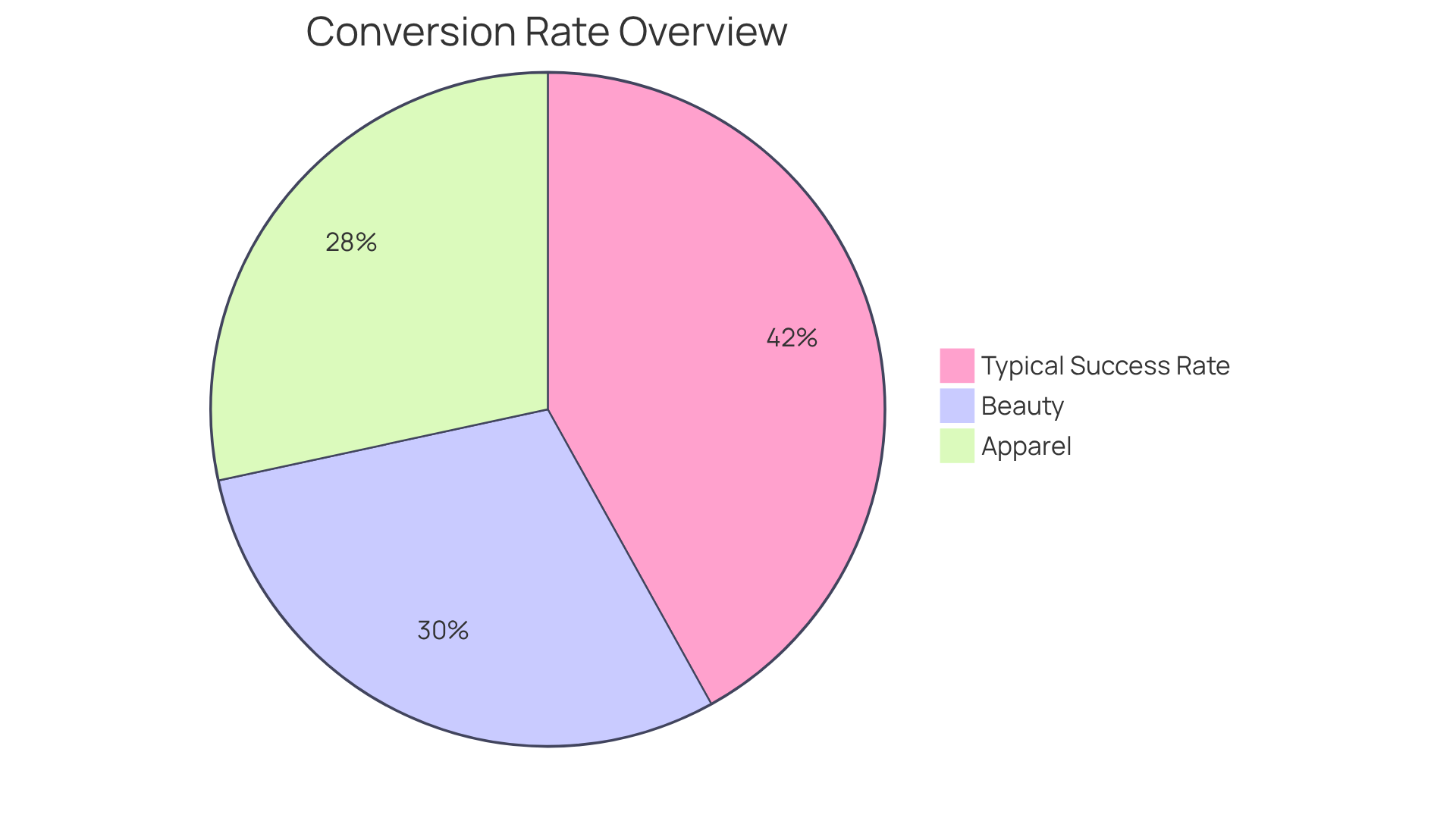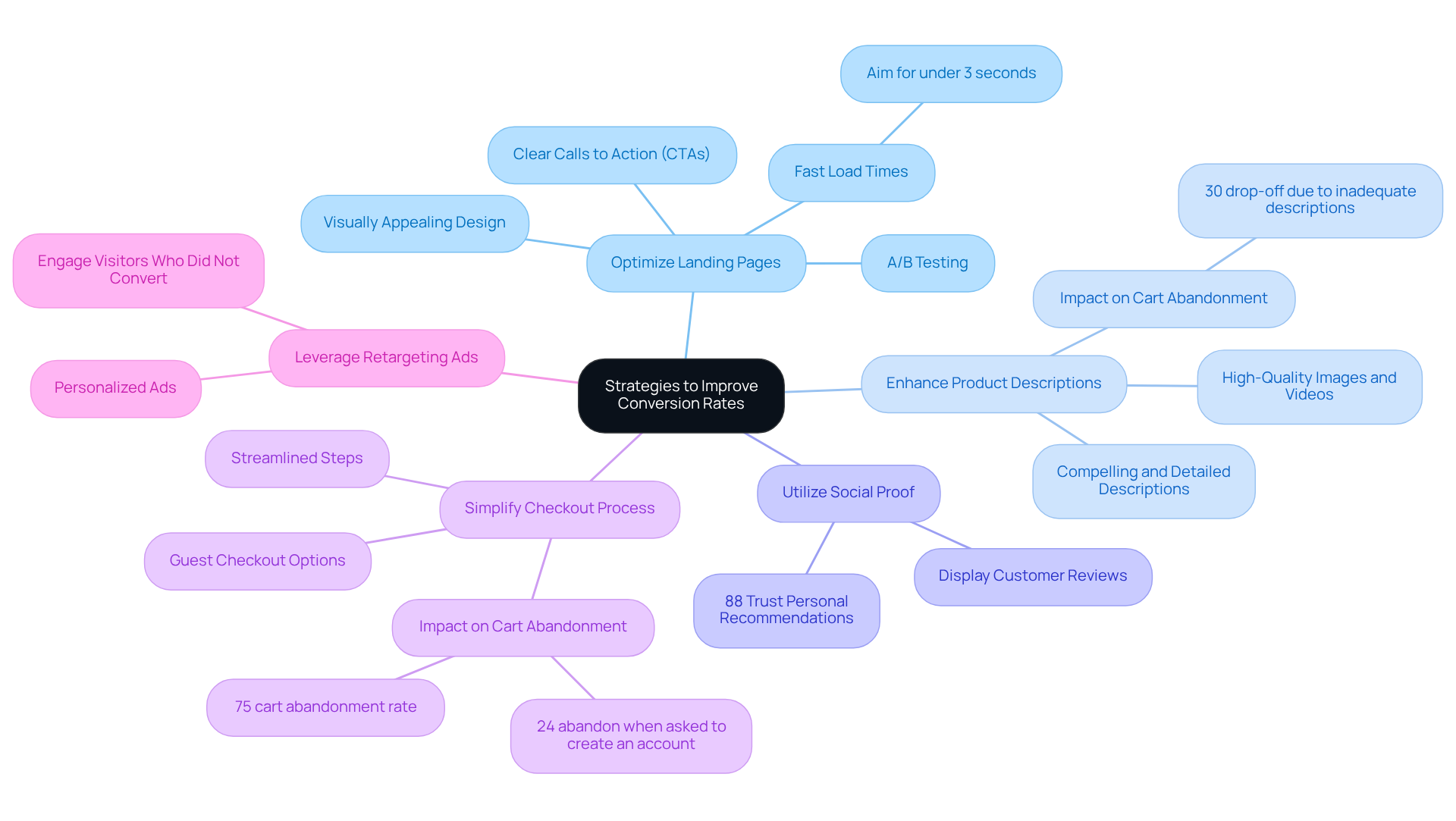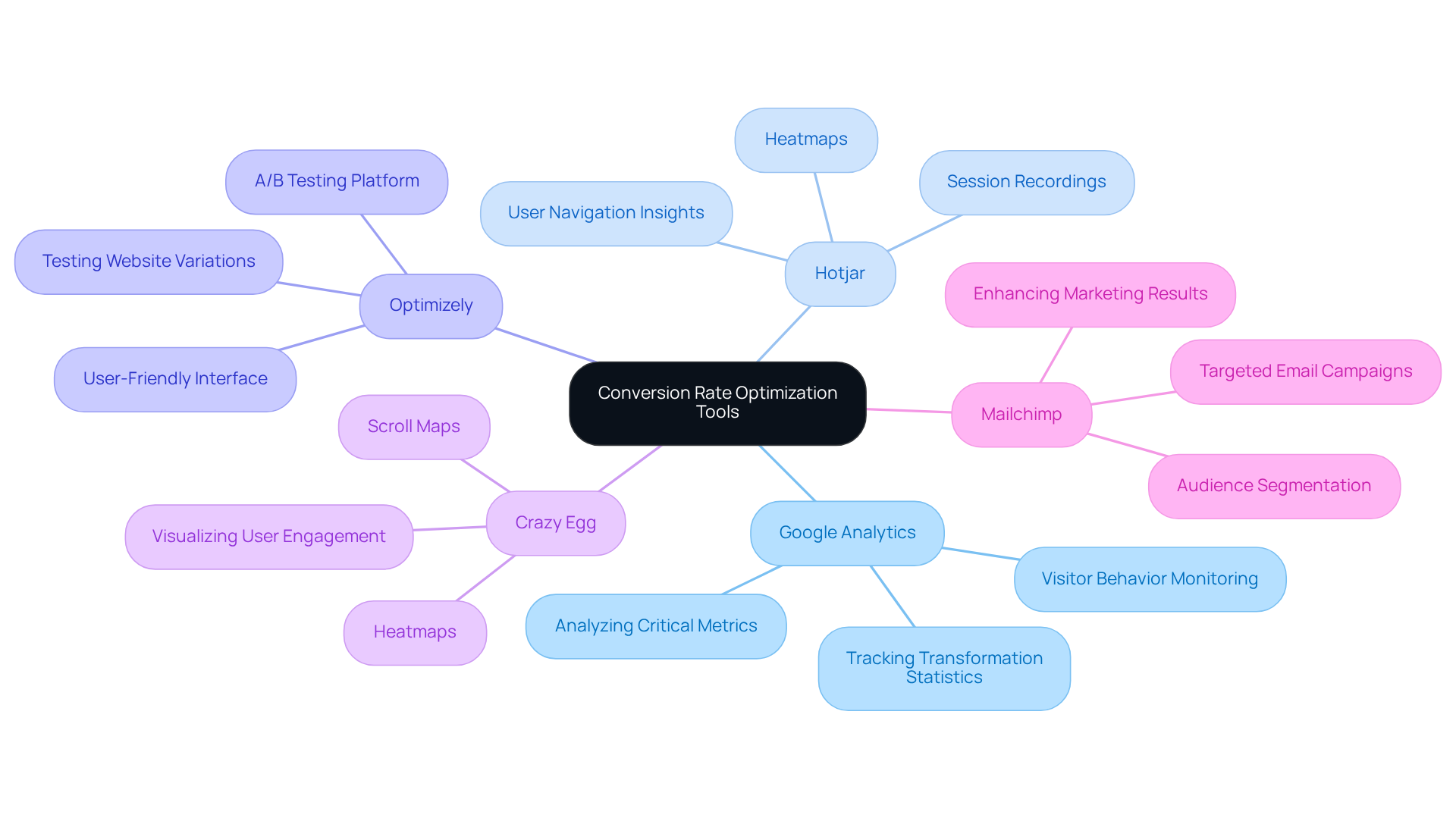
Overview
This article presents the crucial steps for calculating conversion rates for direct-to-consumer (DTC) brands, underscoring its significance in driving revenue and profitability. It articulates a straightforward formula for calculating conversion rates and offers strategic recommendations to enhance these rates. Key strategies include:
- Optimizing landing pages
- Simplifying the checkout process
Thereby reinforcing the essential premise that effective conversion rate management is vital for the success of DTC brands.
Introduction
Calculating conversion rates stands as a pivotal element for direct-to-consumer (DTC) brands aiming for triumph in a fiercely competitive landscape. This vital metric not only signifies the efficacy of marketing initiatives but also directly influences revenue generation. Therefore, it is imperative for brands to comprehend and refine their conversion strategies.
Yet, given the multitude of factors that shape consumer behavior and purchasing decisions, how can DTC brands effectively enhance their conversion rates? This article will elucidate the essential steps for calculating conversion rates, underscore key strategies for improvement, and examine the tools that can foster sustainable growth and profitability.
Define Conversion Rate and Its Importance for DTC Brands
involves defining conversion level as the percentage of visitors to a website who complete a desired action, such as making a purchase. For companies, a healthy typically ranges from 2.5% to 4%. This metric is crucial as it directly impacts revenue; even a slight increase in the success ratio can yield significant financial benefits.
For instance, a brand attracting 10,000 monthly visitors that elevates its success percentage from 2% to 3% could see sales rise from 200 to 300 transactions, greatly enhancing profitability. Given that nearly half of U.S. consumers abandon online purchases due to additional costs, improving becomes even more imperative.
Strategies like emphasizing free shipping can . , a specialist in , underscores sustainable growth and profitability for DTC companies. Their senior-level team, with experience on both the company and agency sides, tailors strategies to meet individual client needs.
For example, a $30M clothing brand partnered with Parah Group to revamp their homepage, refine product pricing, and implement post-purchase upsells, resulting in a 35% increase in . Furthermore, it is essential to note that the apparel category has a success percentage of 2.2%, while the beauty category stands at 2.3%. The typical U.S. add-to-cart percentage is 11%, indicating strong buying intent among users.
Therefore, diligent monitoring and enhancement of sales metrics, particularly , are vital for DTC brands aiming to optimize their marketing efforts and increase their profits.

Calculate Conversion Rate: Step-by-Step Formula
To calculate your , adhere to these crucial steps:
-
Identify the Total Number of Conversions: This represents the count of individuals who completed the desired action, such as making a purchase, within a specified timeframe.
-
Calculate the Total Count of Guests: This includes all distinct individuals visiting your site during that same period.
-
Apply the Formula: Utilize the following formula:
= (Total Conversions / Total Visitors) x 100
For example, if your website recorded 500 conversions from 10,000 visitors, the calculation would be:
Conversion Rate = (500 / 10,000) x 100 = 5%
This indicates that 5% of your visitors completed the desired action, reflecting a robust performance for your site.
Understanding transaction ratios is vital for DTC brands, especially considering that the is 1.65%, a significant decline from previous years. Achieving a places you among the top sites in the industry, with the global average e-commerce conversion percentage at 3.76%. Regularly calculating conversion rates and analyzing your success metrics allows you to identify patterns and refine your marketing strategies effectively. Notably, to comprehend and enhance their performance, underscoring the importance of . Additionally, be aware that 40% of users abandon a page if it takes longer than three seconds to load, highlighting the critical role of in optimization.
At Parah Group, we champion a comprehensive approach to (CRO), ensuring that your paid ads and landing pages are perfectly aligned. Building trust through customer feedback and effective communication can significantly elevate your success rates. By consistently monitoring these metrics and implementing rigorous testing strategies, you can make informed decisions that enhance your overall profitability and growth.

Implement Strategies to Improve Conversion Rates
To enhance your conversion rates, consider implementing the following strategies:
- : Ensure your landing pages are visually appealing, load swiftly, and feature clear calls to action (CTAs). can reveal the most effective designs. Focused landing pages with a single CTA can significantly outperform generic product pages, driving higher conversions.
- Enhance Product Descriptions: Craft compelling, that emphasize benefits and features. Incorporate high-quality images and videos to engage visitors. Brands that enhance their product descriptions can observe a significant decrease in cart abandonment; inadequate descriptions lead to a 30% drop-off among shoppers.
- Utilize Social Proof: Prominently display on product pages to build trust and credibility. Research shows that 88% of consumers trust personal recommendations, making social proof a powerful tool for influencing purchasing decisions.
- : Streamline the steps required to complete a purchase. Providing guest checkout choices and various payment options addresses different customer preferences, greatly decreasing cart abandonment occurrences, which can reach up to 75%. A simple and short checkout process is crucial for calculating conversion rates, given that 24% of shoppers abandon their carts when asked to create an account.
- : Implement retargeting strategies to engage visitors who did not convert on their first visit. Personalized ads can remind them of products they viewed, encouraging them to return and finalize their purchases. This method not only increases success but also improves overall customer interaction.

Utilize Tools and Resources for Conversion Rate Optimization
To effectively , it is imperative to utilize powerful tools for calculating that can transform your approach.
- : This robust tool is essential for monitoring visitor behavior, tracking transformation statistics, and analyzing other critical metrics. It offers profound insights into how users engage with your site, empowering you to make informed decisions.
- Hotjar: Leverage Hotjar for , which provide a clear understanding of where users click and how they navigate your site. This allows you to pinpoint areas ripe for improvement.
- Optimizely: is crucial for conversion rate optimization (CRO), and Optimizely delivers a user-friendly platform to test various website variations effectively.
- Crazy Egg: Much like Hotjar, Crazy Egg offers heatmaps and scroll maps that visualize user engagement on your site, helping you to better understand user interactions.
- Mailchimp: In the realm of email marketing, Mailchimp can significantly aid in segmenting your audience and executing targeted campaigns that enhance results.
By harnessing these tools, can acquire invaluable insights and make , ultimately calculating conversion rates more effectively.

Conclusion
Calculating conversion rates stands as a pivotal element in achieving success for direct-to-consumer (DTC) brands. By mastering and optimizing this essential metric, brands can significantly elevate their profitability and growth. A precisely calculated conversion rate not only showcases the efficacy of marketing strategies but also acts as a compass for making informed decisions that can drive increased sales and enhance customer satisfaction.
This article delineated crucial steps for calculating conversion rates, underscoring the necessity of precise data collection and analysis. Key strategies—including optimizing landing pages, enhancing product descriptions, leveraging social proof, simplifying the checkout process, and utilizing retargeting ads—were identified as effective methods to amplify conversion rates. Moreover, employing tools such as Google Analytics and Hotjar can yield invaluable insights into user behavior, enabling brands to continuously refine their approach.
The importance of conversion rates within the DTC landscape cannot be overstated. By prioritizing this metric and implementing the strategies discussed, brands can not only bolster their success rates but also cultivate a more engaging and effective shopping experience for their customers. Taking proactive measures to comprehend and enhance conversion rates represents a strategic investment in the long-term sustainability and profitability of any DTC brand.
Frequently Asked Questions
What is the conversion rate and why is it important for DTC brands?
The conversion rate is the percentage of visitors to a website who complete a desired action, such as making a purchase. It is important for direct-to-consumer (DTC) brands because it directly impacts revenue; even a slight increase in the conversion rate can lead to significant financial benefits.
What is a healthy conversion rate percentage for DTC companies?
A healthy conversion rate for DTC companies typically ranges from 2.5% to 4%.
How does a small increase in conversion rate affect sales?
For example, if a brand attracting 10,000 monthly visitors increases its conversion rate from 2% to 3%, sales could rise from 200 to 300 transactions, significantly enhancing profitability.
What common issue do U.S. consumers face that affects online purchases?
Nearly half of U.S. consumers abandon online purchases due to additional costs, making it essential for brands to improve their purchase rates.
What strategies can DTC brands use to boost conversions?
Strategies such as emphasizing free shipping can boost conversions by nearly 7%.
What role does Parah Group play in conversion rate optimization?
Parah Group specializes in Conversion Rate Optimization (CRO) and focuses on sustainable growth and profitability for DTC companies by tailoring strategies to meet individual client needs.
Can you provide an example of a successful conversion rate optimization project?
A $30M clothing brand partnered with Parah Group to revamp their homepage, refine product pricing, and implement post-purchase upsells, resulting in a 35% increase in sales effectiveness.
What are the typical conversion rates for different categories?
The apparel category has a success percentage of 2.2%, while the beauty category stands at 2.3%.
What is the typical add-to-cart percentage in the U.S.?
The typical U.S. add-to-cart percentage is 11%, indicating strong buying intent among users.
Why is monitoring and enhancing sales metrics important for DTC brands?
Diligent monitoring and enhancement of sales metrics, particularly calculating conversion rates, are vital for DTC brands aiming to optimize their marketing efforts and increase profits.
FAQs











